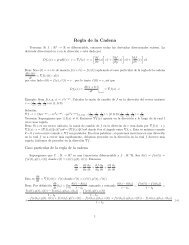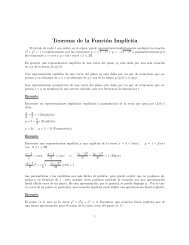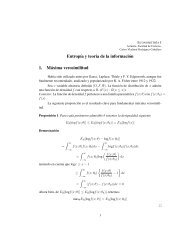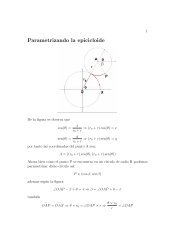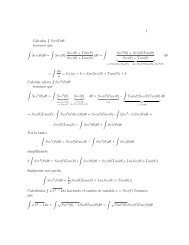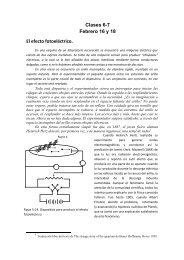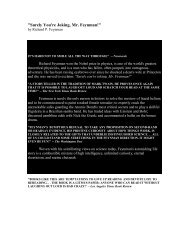Introducci´on a las transiciones de fase y a su simulaci´on
Introducci´on a las transiciones de fase y a su simulaci´on
Introducci´on a las transiciones de fase y a su simulaci´on
Create successful ePaper yourself
Turn your PDF publications into a flip-book with our unique Google optimized e-Paper software.
3<br />
2<br />
d<br />
βh<br />
1<br />
0<br />
e<br />
c<br />
a<br />
b<br />
-1<br />
-2<br />
-3<br />
-1 -0.5 0 0.5 1 1.5<br />
β<br />
Figure 6: Diagrama <strong>de</strong> <strong>fase</strong>s para el mo<strong>de</strong>lo <strong>de</strong> Ising en términos <strong>de</strong> los parámetros β y βh, don<strong>de</strong><br />
β = 1/T y h es el campo externo. La línea oscura a la izquierda es una línea <strong>de</strong> <strong>transiciones</strong> <strong>de</strong><br />
segundo or<strong>de</strong>n, la línea ligera a la <strong>de</strong>recha es una línea <strong>de</strong> transciones <strong>de</strong> primer or<strong>de</strong>n, y el punto<br />
indica la ubicación <strong>de</strong> la temperatura crítica. Las flechas indican posibles caminos a través <strong>de</strong> los<br />
cuales se pue<strong>de</strong>n cambiar los parámetros <strong>de</strong>l sistema, para los cuales el sistema exhibe distintos<br />
tip[os <strong>de</strong>comportamientos.<br />
1<br />
M<br />
0<br />
-1<br />
3<br />
2<br />
1<br />
βh 0<br />
-1<br />
-2<br />
-3<br />
-3 -2 -1 0 1 2 3<br />
β<br />
(a)<br />
0<br />
-2<br />
F -4<br />
-6<br />
-8<br />
-10<br />
-3<br />
-2<br />
-1<br />
β<br />
0<br />
1<br />
(b)<br />
2<br />
3 -3 -2<br />
-1<br />
0<br />
1<br />
2<br />
βh<br />
3<br />
Figure7: Funcionestermodinámicas<strong>de</strong>lmo<strong>de</strong>lo<strong>de</strong>Isingenfunción<strong>de</strong> βy βh: (a)magnetización M,<br />
y (b) energía libre βF(β,h) = −logZ(β,h), para un sistema <strong>de</strong> 16 ×16. La magnetización exhibe<br />
un salto para β gran<strong>de</strong> (T pequeña), que correspon<strong>de</strong> a una transición <strong>de</strong> <strong>fase</strong> <strong>de</strong> primer or<strong>de</strong>n. La<br />
magnetizacióneslaprimera<strong>de</strong>rivada<strong>de</strong> F conrespectoah,yentonces F tieneunaesquina,aunque<br />
es unafunción continua.<br />
17



